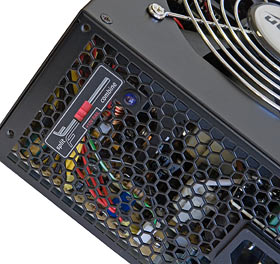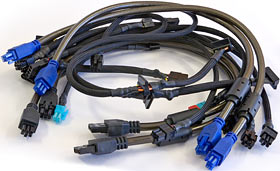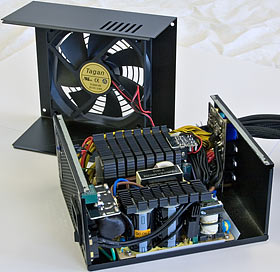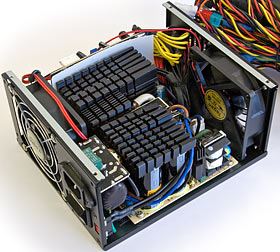
Tagan TG530-U15 and TG530-U22 power supplies
Review date: 18 April 2006 Last modified 03-Dec-2011.
You wouldn't think there was a lot of room left for innovation in the world of PC power supplies.
OK, every now and then some new connector comes along, but you can get plug adapters to deal with that. "Modular" supplies, with plug-in cables that let you clutter your case with only the power wires you actually need, are a neat, fairly recent, development - but they've still been around long enough that the marketers are now trying to fancy them up.
The bottom line, though, is that you could add a few adapters to any decently grunty ATX PSU from, oh, 1999 or so, and use it to run most PCs today.
Power demands have shifted around a bit, but the ratings of the higher wattage PSUs for the last few years have been outrageously higher than practically any computer could use, then or now. Usually, people buy PSUs like that either because they think their pimped and pumped PC actually does need a 650W-plus PSU (it very probably doesn't), or because they like the idea of having a lot of headroom. That's fair enough; it's not as if higher rated PSUs consume any more power when running a given system. Or, of course, they buy the big-ass PSU because it looks cool and doesn't cost much more than a more modestly rated grey-box unit, when compared with the overall cost of a new PC.
In the face of this terrifying lack of good reasons for many people to upgrade their PSU when they upgrade their computer, power supply companies have been forced to think really hard about ways to sell new PSUs.
Making PSUs that're prone to blow up is a pretty good way to get people to buy new ones, but the customer in that case is unlikely to buy another PSU from the same company. So that only works for those chameleon companies with 15 brand names, most of which are on sale in the same markets, adorned with the finest electrical authority approval stickers Cousin Al's inkjet printer can make.
But wait! How about making a modern PSU that can act like an older one?
Doesn't sound exciting? Check this out.
Consumer hard drives, you may have noticed, are cheap. It's also quite cheap to add a heck of a lot of drives to an ordinary desktop box - PATA and SATA controller cards are, also, pretty cheap - to create an unwieldy but affordable home data silo.
If, however, you build a system with a bunch of hard drives in it, kit it out with some overkill-plus-200-watts PSU that you think is sure to be enough to run them all, and then turn it on - it may not turn on.
The reason for this is that consumer drives all spin up when you power them up.
Duh, I hear you say. Of course they do.
If you've got a ton of drives, though, that's bad. The PSU can run the drives just fine, once they're spinning; modern 7200RPM hard drives only need a-few-to-several watts each when they're turning. They probably won't make it to that state, though.
When you press the power button on an ATX PC, what you're doing is shorting together a couple of points on the motherboard, which are connected to ground and pin 14 from the power supply. That's the only green wire going to the ATX, ATX12V, EPS12V or eagerly awaited ATXTRAWIRES motherboard power connector, and it's the one you can connect to any ground (black) wire to power up a PSU that's not plugged into a PC.
With pin 14 shorted to ground, the PSU turns on. More or less. The computer, however, will only power up if the PSU puts some voltage on the grey "PWR-OK" wire (also known as "Power Good").
That will only happen if the power supply measures its output rails as being within tolerance. PWR-OK means the PSU thinks all is well - POST for PSUs, if you will.
Now, when umpteen hard drives try to spin up at once, they simultaneously draw their maximum current from the 12 volt rail. That, if there are enough drives, can cause that rail to sag, resulting in no PWR-OK and no system startup.
(If you're using an old AT power supply, by the way, the turn-on procedure is simpler - an ordinary hardware switch connected directly to the PSU. But there's still a PWR-OK wire.)
"But wait a minute," I hear you say. "If I buy myself a PSU with a 500 watt rating, won't it have, like, a 50 amp 12 volt rating? How much freakin' spin-up current do these drives draw, anyway?"
1: You'd be surprised.
2: Your beefy PSU may not be as beefy as you think.
While the run power ratings for 7200RPM drives are in the single-digit watts, their spin-up current is much higher - they can draw something in the neighbourhood of two amps, peak, from 12 volts.
But that ought to give you capacity for 20 drives from your "500W" PSU, with amps to spare, right?
Well, no, because ordinary Power supplies these days have multiple 12V output circuits. The ATX 2 spec requires two 12V rails. One rail's called 12V1 and goes to the main motherboard power connector and the drive power plugs; the other rail's 12V2, which is meant to feed the CPU via the separate four-pin plug, or eight-pin plug, or whatever the heck else they've thought up in the last fortnight.
The reason for this isn't really that the CPU needs its own special super-clean power. It does, but it's got a whole power supply of its own that takes care of that. The 12V2 rail is just the input to all of those regulators and capacitors in the neighbourhood of the CPU socket. The split rails actually seem to be more for compliance with the UL/EN 60950 safety standard, research into which caused me to rapidly approach a level of glazed-overness which I presume to be in violation of numerous other UL/EN standards.
(If you've got some spare time, though, do feel free to flip through the current ATX spec. It's great to discover that "should a catastrophic failure occur", a power supply should not only not catch fire or emit "excessive" smoke or "molten material", but it also should not make a "startling noise". I suppose this all depends on your definition of "catastrophic failure".)
You can get PSUs with more than two 12V rails now, and different motherboards have different opinions about which rail should feed what components. The upshot of it all, though, is that your "50 amp" 12V rail is been split into two 25 amp rails (at least), each of which are quite likely to barf if connected to a mere ten drives, and may not even be able to manage that, given the optimistic specifications of some PSUs.
Some drives are mellow about this sort of thing (as I discovered when seeing what drives would and wouldn't spin up from FireWire power); if your drives just spin up slower from lower input voltage, and your PSU lets them do that and then says that PWR is OK, all will be well. Do not count on this happening.
SCSI drives have a "delayed start" feature, where you just set a jumper on the back of the drive to make it wait a length of time based on its SCSI ID before spinning up. That solves the problem, but can make a big array take minutes to start up. Not, of course, a problem for servers that are only turned off once in a blue moon.
There's been no equivalent feature for ATA drives until recently. If you've got "SATA II" (or, more correctly... "SATA something else") drives, they ought to support "staggered spin-up", where they, too, spin up in sequence. That's great, but it needs to be supported by the drive and the controller, and you may apparently still have to run some special piece of software from the manufacturer to make it happen.
Some recent drives can also start up in the spun-down state and only spin up when they're needed. That, also, ought to solve the problem - but if you think it's any easier for ordinary users to make it actually work, you are of course wrong.
It's not just infestations of drives that can cause the overloaded-rail problem. If you've got a steaming video card with its own power connector (or two cards, or, hey, six), that can keep PWR-OK low on startup, too.
You can get around the problem by figuring out which 12V rail feeds which connectors, and grafting a new plug or two onto an appropriate output. Or you can throw caution to the wind and just run a nice 10AWG jumper cable from one +12V to another. This may or may not result in an exciting lightning show.
Or you can install a whole second PSU, slaved to the first more or less intelligently (I talk about this issue at the end of this page). That'll work, too.
Or, ladies and gentlemen, you can buy one of these power supplies, because their Unique Selling Point is the ability to run their two 12V rails in ATX-V2 separate mode, or ATX-v1.3 connected-together mode.
This is the TG530-U15, from international megabrand Tagan.
This is the TG530-U22.
Both of them sport a Split/Combine switch for the 12V rails - but only the U15 also gives you a little light to remind you whether the switch is on or not.
The U15 is cooled by a single 120mm fan. The U22 has the same unremarkable 150 by 86 by 160mm casing, but has a pair of 80mm fans, one at the front and one at the back. All things being equal, this means the U15 will be quieter and the U22 will be able to haul more air through a poorly ventilated case, but there won't be a lot of difference for most PCs. Both Tagans have thermally controlled fans, the behaviour of which is unhelpfully explained by a graph on the spec sticker whose X axis is calibrated, not in degrees, but in meaningless percentage points. Never mind - quiet when cold, louder when warmer.
Wires
The U15 is a "modular" PSU with plug-in cables, which you can attach to one four-pin socket and eight six-pin ones ...
...and comes with quite a lot of them.
There's a pair of six pin PCIe video card power cables (you'll only need two if you're running two cards in an SLI or Crossfire setup). These two cables feature "soft touch" plugs that're made out of nicer plastic than the usual nylon, and are also longer and thus easier to grip.
You get two soft touch "Molex" four pin drive power cables, too, each with only one power plug at the end. All of the soft touch cables also have, for some reason, an RFI suppressing ferrite bead built into them. Either it's decorative, or there's something nasty about the RF tolerance of the power supply circuits on hard drives or video cards, or Tagan have seriously screwed up their PSUs' output noise filtering. Take your pick.
You also get two more normal Molex-plug cables, each with the usual pair of plugs, one at the end and one most of the way there. There are two cables with one Molex and one floppy-drive power plug (that's yet another plug type used by some video cards, though I think you have to go back a generation or three from the cutting edge to find it). There are two SATA-plug cables as well, each of which gives you two plugs, like the double Molex cables.
And, rounding out the optional cables, there's one ATX12V four pin power plug, which comes with a red cover on the end that makes it look like an exciting and mysterious pushbutton.
There are also cables permanently attached to the PSU, of course. One 20 pin ATX plug, one four pin plug that mates with the one end of the 20-pinner to make a 24 pin EPS12V plug (that four pin plug has another of the little red covers, which makes more sense on it), one four pin and one eight pin EPS12V auxiliary power connector. So, yes, this PSU can give you a pair of ATX12V plugs, for which some motherboards actually have sockets these days. Auxiliary power connectors have been spawning in greater and greater numbers on tweaky boards; the idea is to provide as many inputs to the same supply rails on the mobo as possible, to reduce the current passing through each of those little skinny PSU 12V wires and thus increase the voltage the mobo actually gets.
As such, these extra connectors are optional, depending on how much power the motherboard needs and how fragile your particular combination of CPU, RAM and motherboard is. With a mainstream CPU at stock speed, various boards will run fine with one or more of their extra power connectors unconnected. If you're winding your PC up to the redline, it doesn't hurt to hook up every extra power cable you can.
The U15 also sports an earth lug covered with a clear removable insulator sleeve. The earth lug's not essential, and can only be useful at all if the chassis of the power supply doesn't make good electrical contact with the PC case. That's impossible with a normal PC, where everything inside is just bare mild steel, but it's perfectly possible with a black-finish PSU like this and one of the various hard-anodised, clear-coated or fancy-painted cases that're popular today. You'll still get reasonable earthing from the power supply mounting screws and the black wires on all of the power plugs, but you'll get a better earth, which can matter for high power applications, if you put a chassis screw somewhere through the lug. The lug and its wire could also be handy for hackers, though you'll still have to carve up a cable or two if you want some positive voltages to go with it.
So, counting it all up: All of the motherboard and video card power connectors you're likely to need, and a maximum of eight Molex plugs, two floppy drive plugs and four SATA plugs.
The U22 isn't modular; all of its cables are already attached, the old-fashioned way.
It's got the same Molex and floppy power plug count, split between two Molex-Molex cables and two Molex-Molex-floppy cables. There are only two SATA plugs, and instead of two ATX12V four pin plugs and an eight pin EPS12V, you get two ATX12Vs that can be clipped together to make one EPS12V. Apart from that, it's got the same plug complement as the U15.
The U22 cables with one plug on the end are 50cm long; the ones with more than one plug are longer, with the first plug at the 50cm mark and then 15cm spacing for the rest. The U15 cables are much the same; a couple are 55cm to the first plug, a couple are 45cm.
Each PSU also comes with a pack of extra bits - five mounting screws (one for the earth lug), nylon and Velcro cable ties, and a bunch of plastic caps for unused cables.
Volts and amps
The TG530-U15 and TG530-U22 don't have quite the same output specifications, but they're close. As the model numbers suggest, they've both got a 530 watt nominal rating.
The U22 offers a 28A 3.3V rail, 48A of 5V, and two 20A 12V rails, which can be combined for a total rating of (only) 32A. The 3.3V and 5V rails ratings added together in the lousy-PSU fake-specs way are 332.4 watts, but their actual aggregate rating is 240 watts, plus a total of 384 watts for 12V no matter which way you slice it. So if you leave the 12V rails split, and draw 20A from one of them, you can only have 12A from the other one.
The aggregate rating for all of the U22's power rails is 510 watts, and the negative rails and +5VSB (standby) rail make up the extra for the full 530 watt rating.
The U15 has maximum +3.3 and +5V rail ratings of only 26 and 30 amps, with an aggregate rating for the two of only 180 watts. Its 12V rails have the same 20A ratings as the U22, though, and combined they're rated for one amp more - 33A. Its overall 12V power rating is therefore, as you'd expect, 12 watts higher at 396 watts, and its aggregate ratings from there on are the same as the U22's.
The difference in 3.3 and 5V ratings isn't likely to matter for modern PCs, since they use efficient switching regulators to step down 12V power to run all of the high-grunt low-voltage stuff.
One thing that may well matter to a select few users, though, is that both of these PSUs have not just -12V outputs, but -5V as well. The ATX spec no longer requires -5V, and most PSUs on the shelves these days don't have it, but every now and then people still strike something that wants it. Those people can add these PSUs to their shortlist (often a very short list...) of options.
Eagle-eyed observers may also have noted that the switch to combine or separate the 12V outputs is not the only red switch on the back of these PSUs.
Yes, that's a good old "115/230" selector switch, on the other side of the power switch from the combiner slider. This is the back of the U22, but the U15 has one too.
Most of the PSUs in the world probably still have one of these switches on them, but a lot of newer PSUs don't. The primary purpose of the switch is to allow you to select the right input voltage to match the country you're in - "115" for 110 to 120V countries, "230" for 220 to 240V ones. The secondary purpose of the switch is to allow you to stop a computer from working in a rather boring way if you use the "230" setting in "115" countries, or in a rather more exciting and destructive way if you use the "115" setting in "230" countries.
The selector switch isn't, of course, a big problem for anybody who isn't taking their computer around the world (or around the country, in those few exciting nations where different provinces have different mains standards...), but its very existence means that the PSUs I looked at don't have Power Factor Correction, or PFC. PFC is another selling point for a lot of fancy PSUs, but its only practical effect for home and small business users pretty much everywhere in the world is that the PSU automatically adjusts to any input voltage. If you want to know what PFC's actually all about, I explain it here.
(It seems that Tagan, like some other power supply companies, sell PFC and non-PFC versions of these PSUs. Their German site shows the PFC versions, proudly declared to have power factors "up to 0.99", and with no second red switch.)
Inside, these PSUs contain nothing amazing, but one thing they don't contain is the surprisingly large amount of nothing that you'll find inside a lot of cheap power supplies. This is the U15; note the big fan in the lid, and the heat sinks that (a) vaguely channel the air flow towards the midline of the PSU and (b), more importantly, are short enough that the fan has some room to get the air moving in the first place.
The U22 heat sink layout is similarly suited to its fan layout - here, the sinks slope down towards the intake and outlet fans, which probably doesn't actually have much effect on how well the PSU keeps its cool, but which still shows pleasing attention to detail.
Getting one
Here in Australia, Aus PC Market are selling the TG530-U15 for $AU165 delivered; Australian shoppers can click here to order one. The TG530-U22 is $AU176 delivered; Aussie shoppers can click here for that one.
Note that the Australian package for these PSUs doesn't include an IEC lead to actually plug the thing into the wall. All true nerds have at least seven spare IEC cables lying around the place at any given time, of course, but Aus PC will sell you one if you want. Or you can hit eBay and buy several old scungy ones for about the same money.
As I write this, though, there are a few places in the States from which you can buy the U15 and other Tagan PSUs (quite a few, actually, if you use a proper price search engine instead of my dumb affiliate link).
Overall
Never mind the power ratings, feel the features.
The ATX v2 split rail standard was, widely, presented as an exciting new feature that every home should have. It isn't, and it's nice to see PSUs that let you disable it.
The fact that these PSUs also give you a full complement of negative rails is icing on the cake. And they don't even cost much.
Any brand name PSU with a reasonable rating will run any sensible PC today, and that's not likely to change. These Tagans, however, don't just suit certain niche users down to the ground. They also give everybody else insurance against problems that they might, perhaps, later have. Buy one, set it to combined-rail mode, and relax in the knowledge that adding stuff in the future won't create weird and wonderful problems.
Highly recommended.
Buy
one!
Readers in Australia or New Zealand can purchase the TG530-U15 from Aus PC Market. The U22 is no longer available, but it's been replaced by a
580 watt version of the U15.
Click here for the 530 watt version of the U15.
Click here for the 580 watt version (currently mislabeled as a 530 in the product title, but it's
the 580, trust me.)
If you're not in Australia or New Zealand,
Aus PC Market won't deliver to you. Try a
price search at
Shopping.com!









